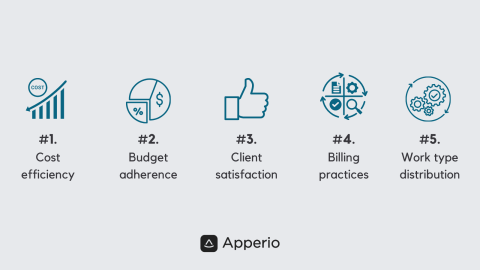Harnessing real-time and historical legal spend data to drive better decisions

Gone are the days when legal spend analytics were seen as a tool to "beat up" law firms. Instead, modern general counsels are using insights to build trust, drive efficiency, and align legal operations with business objectives.
Consider this: 90% of in-house counsels have little understanding of their external legal spend, while 4 out of 5 companies plan to cut their legal spend over the next two years. This disconnect highlights the need for data-driven decision-making in legal operations.
In this blog, we'll cover how combining historical and current legal spend data can improve your panel review process. We'll show you how to:
- Gain clear visibility into your legal spend and matter distribution
- Predict future legal needs with greater accuracy
- Define meaningful KPIs that go beyond simple cost metrics
Legal spend data: Why bridging past and present matters
While historical legal spend data is crucial for understanding trends and patterns in your legal costs, incorporating real-time data provides a complete picture, enabling real-time strategic adjustments and more successful panel reviews.
Here’s why combining the two is essential:
- Identify cost patterns and behaviors: Historical legal spend data reveals long-term trends, while real-time data highlights immediate changes and firm behaviors.
- Improve budget forecasts and work volume predictions: Use historical data as a foundation, then refine with real-time information to provide law firms with realistic expectations.
- Uncover inefficiencies and opportunities: Long-term analysis shows persistent issues, while real-time legal spend data indicates areas for immediate improvement and potential for value creation.
- Evaluate law firm performance holistically: Assess both long-term performance and real-time service quality against nuanced KPIs.
By leveraging both data sets, you can answer critical questions, like:
- Do increased rates correlate with improved service or decreased efficiency?
- Which firms consistently provide the best value and adhere to billing guidelines?
- How does each firm's performance compare across different practice areas or regions?
- Are your panel firms leveraging modern tools to enhance productivity?
To sum up: This data-driven approach helps legal departments demonstrate tangible value to their organizations while building stronger, more productive partnerships with their panel firms.
Now we’ve covered the importance of combining historical and current data, let’s look at how to leverage this information to create helpful Key Performance Indicators (KPIs).
5 legal spend data KPIs for panel review
KPIs are essential tools for evaluating and enhancing the performance of your legal panel. They allow you to measure both cost-effectiveness and service quality, providing a comprehensive view of your legal service providers.
When setting KPIs for your legal panel, consider metrics that go beyond simple cost measures. Here are some valuable KPIs to consider:
- Cost efficiency: Measures the value obtained from legal expenditures, not just the raw cost.
- Budget adherence: Tracks the number of matters going over budget, indicating a firm's ability to anticipate needs and contribute to your operational resilience.
- Client satisfaction: Assesses the ratio of complaints to open matters, indicating the firm's reliability and professionalism.
- Billing practices: Evaluates adherence to billing guidelines and regularity of invoicing.
- Work type distribution: Analyzes the ratio of billable-hours driven matters to fixed fees, showing a firm's willingness to move towards predictable costs.

Leveraging KPIs in panel reviews
During panel reviews, KPIs provide a data-driven foundation for decision-making. They help you:
- Assess current panel value and behaviors: Review not just the cost, but the overall value and operational behaviors of your law firms.
- Predict future volumes: Use historical data to refine your ongoing requirements and align law firms' perceptions with your expectations.
- Have informed conversations: Use shared data to have open, honest discussions about performance, upcoming work, and strategic alignment.
- Drive continuous improvement: Establish ongoing monitoring of agreed KPIs, fostering a culture of accountability and improvement.
By using KPIs effectively, you transform panel reviews from a cost-cutting exercise into an opportunity for creating value. This allows you to:
- Build trust and partnership with your law firms
- Ensure you have the right blend of skills and jurisdictional coverage for upcoming years
- Drive competition and realism in the tender process
- Align your legal operations more closely with broader business objectives
- Focusing on these KPIs allows you to create a more transparent and mutually beneficial relationship with your legal panel.
➡️Related reading: 5 key metrics every in-house team should track
Now, wrangling the data alone is a huge challenge. So, what’s the best way to do this? Enter: legal spend management technology.
Modern tech: A smarter way to manage panel reviews
Modern legal spend management technology can significantly enhance your panel review process. Here's how:
- Comprehensive insights: Advanced tools—like Apperio—provide real-time data on your legal spend, giving you a complete picture for more informed panel reviews.
- Enhanced relationships: With increased transparency, you and your law firms can engage in open, honest discussions—building trust and stronger partnerships.
- Meaningful metrics: Tools like Apperio allow you to set clear, measurable KPIs during panel reviews. These KPIs can include metrics such as adherence to budgets, billing regularity, and efficiency in case handling, helping to evaluate and benchmark the performance of law firms objectively.
- Future-focused planning: Advanced tools provide predictive analytics that help GCs use historical data to forecast future legal needs accurately. This helps you select firms that will meet both current and upcoming challenges.
- Proactive cost management: Tools like Apperio can even identify areas for spend optimization and efficiency improvements. It's about making smarter financial decisions.
- Continuous improvement: Better still, these tools allow you to monitor firm performance year-round. This allows for regular, constructive conversations with your firms, helping them improve continuously. Panel reviews become part of an ongoing enhancement process.
By using this tech, you're creating partnerships that actually work for both sides. Yes, it allows you to make legal operations more cost efficient, but it also adds much greater value.
Moving from cost-reduction to value creation
By harnessing the power of comprehensive legal spend data and leveraging modern technology, you can turn your panel review process into a catalyst for continuous improvement and mutual growth.
Just to recap, the key to success lies in:
- Combining historical and real-time data for a complete picture of your legal spend
- Implementing meaningful KPIs that go beyond simple cost metrics
- Utilizing modern legal spend management technology to gain real-time insights and facilitate ongoing performance monitoring
Your next step: As you move forward, consider how you can implement these strategies in your next panel review.
Ready to elevate your panel review process? Learn how leading tech can help you. Book a demo here today.
Sources: https://www.apperio.com/blog/data-driven-panel-review